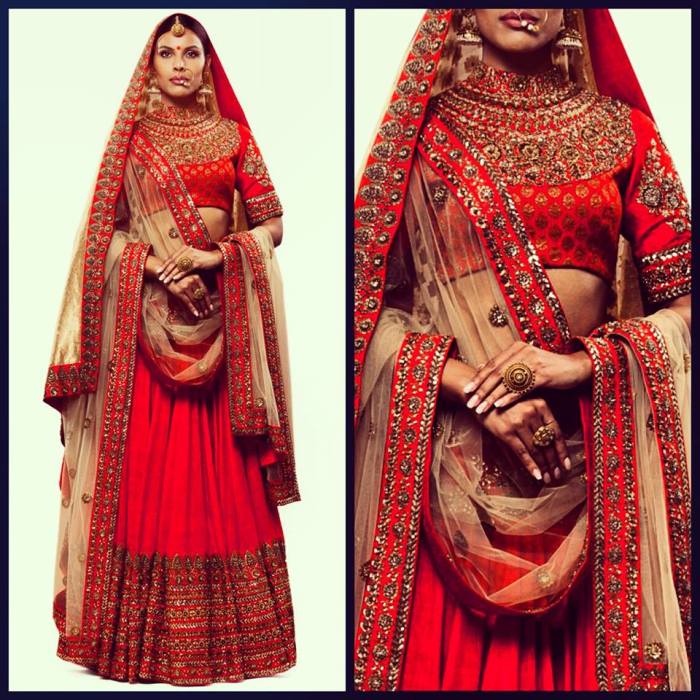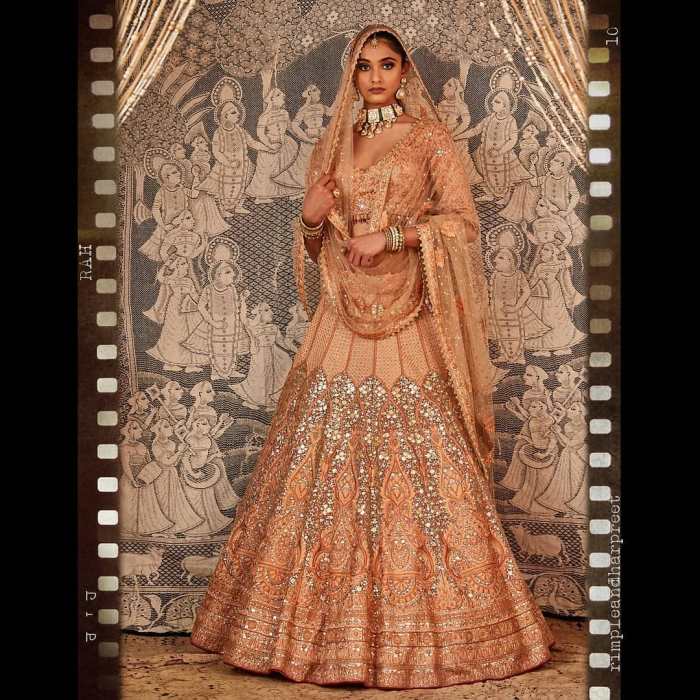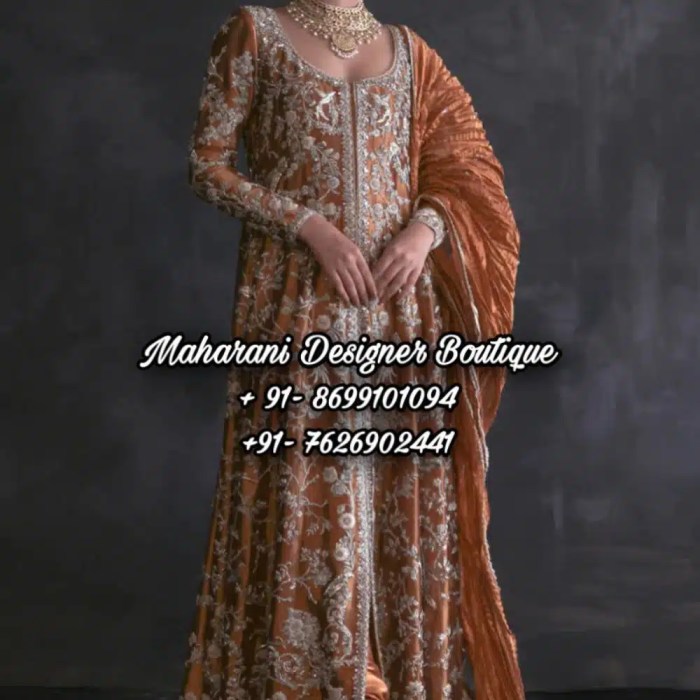Top Indian Wedding Dress Designers
Indian wedding dresses designer – The Indian wedding dress industry is a vibrant tapestry of creativity and tradition, with numerous talented designers shaping its evolution. This section explores some of the most influential figures, examining their unique styles and contributions to the industry.
Ten Influential Indian Wedding Dress Designers and Their Signature Styles
The following list showcases ten designers who have significantly impacted the landscape of Indian bridal wear, each with their distinctive aesthetic:
- Sabyasachi Mukherjee: Known for his opulent, regal designs often incorporating traditional Bengali motifs and rich embroidery.
- Manish Malhotra: Celebrated for his glamorous, contemporary designs, blending traditional elements with modern silhouettes.
- Anita Dongre: Renowned for her sustainable and ethically produced designs, often featuring intricate hand embroidery and natural fabrics.
- Tarun Tahiliani: Famous for his fluid, ethereal designs that seamlessly blend traditional Indian techniques with contemporary Western influences.
- Neeta Lulla: Known for her intricate embroidery and embellishments, often incorporating traditional Indian motifs in a modern context.
- Ritu Kumar: A pioneer in reviving traditional Indian textile techniques and crafts, her designs are characterized by their authenticity and timeless elegance.
- Abu Jani Sandeep Khosla: Famous for their exquisite craftsmanship and opulent designs, often incorporating intricate embroidery and luxurious fabrics.
- Rohit Bal: Known for his dramatic, theatrical designs that often feature bold colors, intricate embellishments, and unique silhouettes.
- Anamika Khanna: Celebrated for her modern, avant-garde designs that reinterpret traditional Indian aesthetics in a contemporary way.
- Masaba Gupta: Known for her bold, contemporary designs that blend traditional Indian patterns with modern silhouettes and a playful aesthetic.
Comparative Analysis of Three Leading Designers’ Design Philosophies
Comparing Sabyasachi Mukherjee, Manish Malhotra, and Anita Dongre reveals distinct design philosophies. Sabyasachi focuses on opulent grandeur, incorporating rich textiles and traditional motifs. Manish Malhotra prioritizes glamour and contemporary appeal, blending tradition with modern silhouettes. Anita Dongre emphasizes sustainability and ethical production, incorporating natural fabrics and intricate handwork.
Chronological Emergence of Key Designers and Milestones
Tracing the emergence of these designers reveals a fascinating evolution. Ritu Kumar, a pioneer, laid the groundwork for reviving traditional techniques. Subsequently, designers like Manish Malhotra and Sabyasachi Mukherjee popularized contemporary interpretations of traditional styles, while newer designers like Masaba Gupta continue to push boundaries.
| Designer | Price Range (INR) | Style | Notable Clients |
|---|---|---|---|
| Sabyasachi Mukherjee | 5,00,000 – 20,00,000+ | Opulent, Regal | Anushka Sharma, Deepika Padukone |
| Manish Malhotra | 3,00,000 – 15,00,000+ | Glamorous, Contemporary | Kareena Kapoor Khan, Priyanka Chopra |
| Anita Dongre | 1,00,000 – 8,00,000+ | Sustainable, Ethically Produced | Sonam Kapoor, Dia Mirza |
| Tarun Tahiliani | 4,00,000 – 18,00,000+ | Fluid, Ethereal | Various high-profile clients |
Regional Variations in Indian Wedding Dress Styles
India’s diverse regions boast unique wedding attire, reflecting local traditions and craftsmanship. This section explores these regional variations in detail.
Distinctive Characteristics of Wedding Dresses from Different Regions of India
Significant regional differences exist in fabrics, embellishments, and silhouettes. For instance, South Indian brides often wear Kanjeevaram silk sarees, while North Indian brides may opt for heavily embroidered lehengas. Western India features a blend of both styles.
Traditional and Modern Interpretations of Wedding Attire from Each Region
Traditional styles are often reinterpreted with modern twists. A Kanjeevaram saree might be paired with a contemporary blouse, or a lehenga might incorporate a modern silhouette while retaining traditional embroidery.
Impact of Regional Fabrics and Embellishments on Wedding Dress Design

Source: stylesgap.com
Regional fabrics and embellishments play a crucial role in defining the aesthetic. The rich silk of Kanjeevaram, the intricate embroidery of Banarasi, and the vibrant colors of Rajasthani textiles all contribute to the unique character of regional bridal wear.
Key Features of Wedding Dresses from Three Different Regions
- South India: Kanjeevaram silk sarees, rich gold embellishments, traditional temple jewellery.
- North India: Heavily embroidered lehengas, vibrant colors, intricate zardozi work.
- West India: A blend of styles, often incorporating elements from both North and South Indian traditions.
Evolution of Indian Wedding Dress Design
Indian wedding dress design has undergone a significant transformation over time, influenced by social changes, technological advancements, and global influences. This section traces this evolution.
Historical Evolution of Indian Wedding Dresses
From the simple, elegant sarees of the past to the elaborate lehengas and gowns of today, the evolution reflects changing social norms and access to new materials and techniques. Early styles were often simpler, focusing on the quality of the fabric and minimal embellishment. The introduction of new technologies and global influences gradually led to more elaborate designs.
Iconic Wedding Dresses from Different Eras and Their Cultural Significance
Iconic examples include the simple yet elegant sarees worn by brides in the early 20th century, reflecting a focus on modesty and tradition. Later eras saw the rise of more elaborate styles, reflecting changing social attitudes and increased access to luxury materials.
Key Factors Influencing the Evolution of Indian Wedding Dress Design
Social changes, such as increased female participation in the workforce and changing attitudes towards marriage, have influenced designs. Technological advancements, like the introduction of new weaving techniques and embroidery machines, have also played a crucial role. Global influences, such as exposure to Western fashion trends, have also impacted the evolution of Indian bridal wear.
Timeline Illustrating Major Shifts in Indian Wedding Dress Design
A timeline would show the shift from simpler, more traditional styles to the more elaborate and diverse designs seen today, highlighting key milestones and influential designers.
Materials and Embellishments in Indian Wedding Dresses

Source: googleusercontent.com
The artistry of Indian wedding dresses designer showcases incredible detail and craftsmanship, a world away from the simpler designs. However, even the most intricate lehenga finds a counterpart in the virtual world; learning how to make wedding dress stardew offers a fascinating contrast to the real-world complexities of high fashion. Ultimately, both pursuits celebrate creativity and the desire to create something beautiful for a special occasion, though on vastly different scales.
The richness and beauty of Indian wedding dresses are enhanced by the use of exquisite fabrics and intricate embellishments. This section delves into the details of these materials and techniques.
Common Fabrics Used in Indian Wedding Dresses
Silk (Banarasi, Kanjeevaram, Raw silk), brocade, velvet, and other luxurious fabrics are commonly used. Each fabric possesses unique properties that contribute to the overall aesthetic and drape of the garment. Silk, for example, offers a luxurious sheen and drape, while velvet adds a rich texture.
Types of Embellishments Used to Decorate Indian Wedding Dresses
Intricate embroidery (zardozi, aari, chikankari), beadwork, zari work, and other embellishments are used extensively. Each technique adds a unique layer of artistry and detail, enhancing the overall opulence of the garment.
Comparison of Techniques Used in Different Types of Embellishments
Zardozi work, for instance, uses metallic threads for intricate designs, while chikankari uses white embroidery on delicate fabrics. The techniques differ in their intricacy, the types of threads used, and the overall effect they create.
| Embroidery Type | Description | Region of Origin | Examples |
|---|---|---|---|
| Zardozi | Intricate metallic thread embroidery | Lucknow, India | Lehengas, sarees |
| Aari | Surface embroidery using a hooked needle | Various regions of India | Sarees, blouses |
| Chikankari | White embroidery on muslin | Lucknow, India | Kurtis, sarees |
| Kasuti | Traditional counted-thread embroidery | Karnataka, India | Sarees, dupattas |
Modern Trends in Indian Wedding Dress Design

Source: maharanidesigner.com
Contemporary Indian wedding dress design showcases a fascinating blend of tradition and innovation. This section explores the current trends and their influence.
Current Trends in Indian Wedding Dress Design
Current trends include a move towards more streamlined silhouettes, incorporation of unconventional colors, and a greater emphasis on sustainable and ethically sourced materials. There’s also a growing interest in fusion styles, blending traditional Indian elements with Western influences.
Modern Interpretations of Traditional Styles
Traditional styles are being reimagined with modern twists, resulting in designs that are both classic and contemporary. For instance, a traditional lehenga might be paired with a modern blouse or a saree might be draped in a contemporary style.
Contemporary Designers Pushing Boundaries of Traditional Design
Many designers are experimenting with unconventional materials, silhouettes, and embellishments, pushing the boundaries of traditional Indian wedding dress design. This results in unique and innovative designs that capture attention.
Influence of International Fashion Trends on Indian Wedding Dress Design, Indian wedding dresses designer
International fashion trends have influenced Indian wedding dress design, leading to the incorporation of Western silhouettes and design elements into traditional garments. This fusion creates a unique and dynamic style.
Illustrative Examples of Designer Wedding Dresses: Indian Wedding Dresses Designer
This section provides detailed descriptions of three designer wedding dresses, showcasing their design elements, materials, and overall aesthetic.
Detailed Descriptions of Three Designer Wedding Dresses
Dress 1: Imagine a Sabyasachi lehenga in deep crimson velvet, intricately embroidered with gold zardozi work and featuring a flowing skirt and fitted choli. The design is inspired by Mughal architecture, reflecting opulent grandeur.
Dress 2: Picture a Manish Malhotra lehenga in a light pastel shade, featuring delicate embroidery and a contemporary silhouette. The design is inspired by modern minimalism, showcasing a blend of tradition and modernity.
Dress 3: Envision an Anita Dongre lehenga crafted from sustainable silk, adorned with hand-embroidered floral motifs. The design is inspired by nature, reflecting a commitment to ethical and sustainable practices.
Craftsmanship and Techniques Used in Creating a Specific Designer Wedding Dress
Consider a Sabyasachi lehenga: The intricate zardozi embroidery would involve countless hours of meticulous handwork by skilled artisans, using fine metallic threads and beads to create elaborate patterns. The process reflects a dedication to traditional craftsmanship.
Color Palettes and Design Motifs in Contemporary Designer Wedding Dresses
Contemporary designers often use a range of colors, from classic reds and golds to more unconventional shades like pastels, jewel tones, and even monochrome palettes. Design motifs range from traditional floral and geometric patterns to more abstract and modern designs. The choice of color and motif reflects the designer’s unique aesthetic and the bride’s personal style.
FAQ Guide
What are some common fabrics used in Indian wedding dresses?
Silk, brocade, velvet, and Banarasi silk are popular choices, each offering unique textures and draping qualities.
How much does a designer Indian wedding dress typically cost?
Prices vary widely depending on the designer, materials, and embellishments, ranging from several thousand to tens of thousands of dollars.
How long does it usually take to create a custom designer Indian wedding dress?
The creation process can take several months, often requiring multiple fittings and adjustments to ensure a perfect fit and desired aesthetic.
What is the significance of color in Indian wedding dresses?
Color choices often hold cultural and symbolic meaning, with reds and golds traditionally representing auspiciousness and prosperity.
